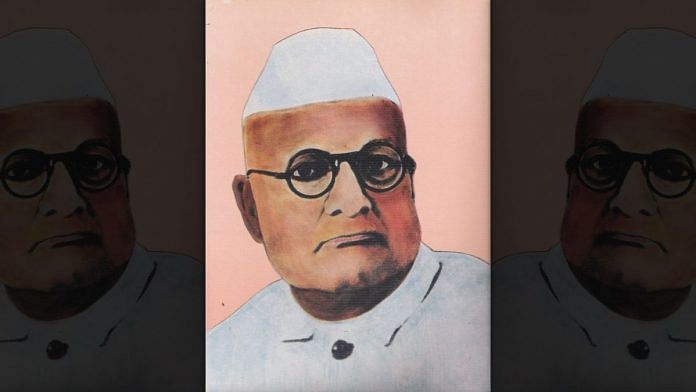
At the busy four-way junction of Narayanaguda road that travels to Secunderabad stands a three-storey, off-white building steeped in the social history of Telangana. At first glance, it looks like any other government school, seamlessly blending into its surroundings. But a board tells you all you need to know: Madapati Hanumantha Rao Girls High School — est. 1928. It was the first Telugu and girls’ school in the state.
Although the name might not ring a bell for many across India, who instantly recall P.V. Narsimha Rao or C. Narayana Reddy, people of Telangana call Madapati Hanumantha Rao ‘Andhra Pitamaha’ — a pioneer of the modern Telugu nation. Not only did he encourage people to stand up against the autocratic regime of the Nizam in the independent kingdom of Hyderabad, but Hanumantha Rao is also credited for his role in the renaissance of the Telugu language and literature.
In his 1991 book, The Great Indian Patriots (Volume 2) author and journalist P. Rajeswar Rao writes: “He was a guide, friend and philosopher to many. Anyone who approached him with a problem never returned without a solution. Thus, he was everything to every one… He had no enemies, personal or political, and was indeed an Ajatasatru. Like Picasso in painting, he had different periods in his career as a public man.”
Also Read: Mir Osman Ali Khan, Hyderabad Nizam who wore cotton pyjamas & used a diamond as paper weight
Madapati Rao’s rise as a public figure
Rao was born on 22 January 1885 into a middle-class family in Pokkunuru village of Krishna district in Andhra Pradesh. Rao’s father, Vekatappayya, was a ‘karanam’ (clerk) and is said to have died early in Rao’s childhood. Growing up in his uncles’ house, who were employed by Nizam Mahboob Ali Khan’s government, he also followed in their footsteps and joined the education department as a clerk in 1904, where he worked for eight years. Soon after, he moved to Hyderabad to become a lawyer.
After years of practice, in 1921, Rao transformed into a public figure of immense importance to the Telugu people.
On 11 and 12 November that year, the Nizam’s States’ Social Reforms Conference was conducted in English, Urdu and Marathi. Though the absence of Telugu itself was a contention, the matters were made worse when one of the participants, who wished to move a motion in his mother tongue, was denied the opportunity to do so. The incident enraged the Telugu-speaking population of the state. Leading from the front, Rao and 11 other leaders formed the ‘Andhra Jana Sangh’ to mobilise and bring about a social and cultural consciousness among Telugu-speaking people.
As the Secretary of the organisation, Rao rose to prominence in Telugu society. Author and historian Sarojini Regani writes in her 1956 book Highlights Of The Freedom Movement In Andhra Pradesh: “From this time onwards Madapati Hanumantha Rao proved to be the guiding spirit of the movement for social and cultural upliftment of Telangana people. This was the beginning of the Andhra movement in the Hyderabad State.” The organisation was responsible for building several libraries, reading rooms and private schools with the aim of ‘enlightening’ the Telugu masses. It also undertook archival projects that sought to unearth the ‘glorious past of Telugu-speaking people’.
Rao is also widely credited for the development of Sri Rajaraja Andhra Bhasha Nilayam and Raja Raja Narendraandhra Bhasha Nilayam — two of the oldest and most prestigious libraries in the state.
Also Read: MC Reddy led Telangana Agitation. Indira Gandhi was smarter—she made him UP Guv instead
Contribution to education
As a social reformer, Madapati Hanumantha Rao also pioneered the noble cause of supporting women’s literacy at a time when girls weren’t even allowed to go to school.
Along with social reformer Vadlakonda Narasimha Rao, Madapati Rao built the state’s first Telugu school in 1928 in Narayanaguda, Hyderabad with a mere 35 students in attendance. This was strictly against the diktat of Mir Osman Ali Khan government that prohibited setting up Telugu schools, besides restricting women’s education.
Rao also encouraged compulsory elementary education with the Telugu language as the medium of instruction and is said to have been a proponent of Gandhian values and upliftment of Dalits. As Rajeswar Rao writes: “He was a nationalist to the core wearing khaddar although. He never discarded the traditional dhoti, coat and turban, which he later replaced by a Gandhi cap… and worked for the uplift [sic] of scheduled caste and backward classes while encouraging the merited and the deserving.”
Also Read: KCR’s Telangana is utopia for his caste group, land barons. Oppressed continue to suffer
A writer and a statesman
A first-rate writer and poet, Rao’s articles can be found in several journals like Sujata, Andhrabharati, Deshbandhu, Golconda Patrika. He also wrote a total of 13 stories that were published in 1911 under the title ‘Mallikagucham’. Apart from his original works, he is said to have translated writings by Premchand and Bankim Chandra Chattopadhyay’s Anandamath into Telugu.
Rao was elected as the first mayor of Hyderabad Municipal Corporation in 1951, and held that post till 1954 after the Hyderabad kingdom joined hands with the Indian republic in 1948. He was also the first chairperson of the Andhra Pradesh Legislative Council from 1958 till 1963.
In 1955, the Indian government conferred him with the Padma Bhushan, making him the first Telugu person to receive this prestigious award.
Unlike other social reformers, Madapati Hanumantha Rao focused on contributing to society, particularly in the area of education and language, which have benefited thousands of Telugu-speakers. Rao was deeply respected and admired even by people of different political backgrounds and ideologies. He passed away at the age of 86 on 11 November 1970, after being ill for over a year.
(Edited by Srinjoy Dey)

COMMENTS